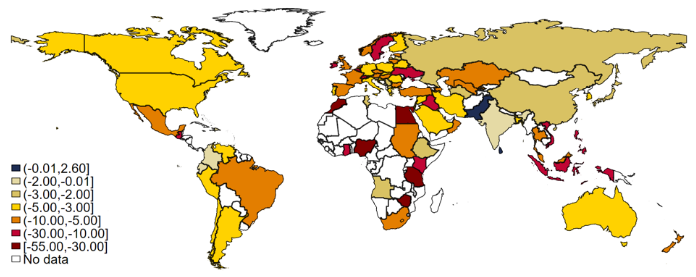What would happen if foreign direct investment (FDI) simply disappeared? Or, more specifically, what would “a hypothetical world without outward and inward FDI from and to low- and lower-middle-income countries” look like? A brand new study tries to quantify this hypothetical. They find,
On average, the gains from FDI in the poorer countries in the world amount to 7% of world’s trade in 2011, the year of our counterfactual analysis. Second, all countries lose from the counterfactual elimination of FDI in the poorer countries. Third, the impact is heterogeneous. Poorer countries lose the most, but the impact varies widely even within this group – some lose over 50% and some very little. The impact on countries in the rest of the world is significant as well. Some countries lose a lot (e.g. Luxembourg, Singapore, and Ireland) while others (such as India, Ecuador, and Dominican Republic) lose less. Pakistan and Sri Lanka actually see an increase in their total exports due to the elimination of FDI.
Figure 1 Percentage change in total exports from eliminating outward and inward FDI to and from low- and lower-middle-income countries

There’s more:
On average, the gains from FDI amount to 6% of world’s welfare in 2011. Further, all countries in the world have benefited from FDI, but the effects are very heterogeneous. The directly affected low- and lower-middle-income countries see welfare changes up to over 50% (Morocco and Nigeria), while some of the remaining 68 countries, such as Ecuador, Turkmenistan, and Dominican Republic are hardly affected. A higher country-specific production share of FDI leads to larger welfare losses, all else equal. Intuitively, a larger importance of FDI in production leads to larger welfare losses when restricting FDI. A larger net log FDI position leads to larger welfare losses. Intuitively, if a country has more inward than outward FDI, restricting FDI will lead to larger welfare losses, as FDI is complementary to other production factors and therefore overall income increases more than FDI payments.
Figure 2 Welfare effects of eliminating outward and inward FDI to and from low- and lower-middle-income countries (%)

The authors conclude, “Overall, the analysis reveals that FDI is indeed an important component of the modern world economic system. The results suggest positive payoffs to policies designed to facilitate FDI, particularly those concerning protection of intellectual property.”